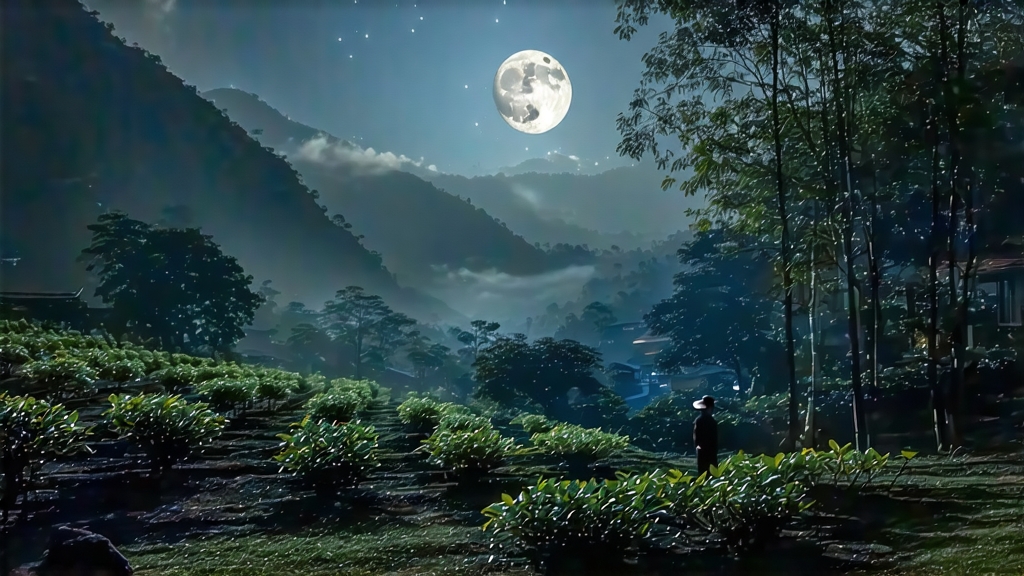
Tucked high on the forested ridges of Yunnan’s Simao and Lincang prefectures, a tea that refuses to see the sun quietly earns the devotion of growers, poets, and sommeliers. International markets label it simply “Yunnan White,” but within China it is cherished by a more romantic name—Yue Guang Bai, literally “Moonlight White.” The title is not poetic license; it is technical description. Every step of its making is timed to lunar rhythm, turning the new-born bud and its accompanying leaf into a blade of silver that seems to store moonbeams. To understand why this happens, one must first step back into the region’s history, geography, and the slow conversation between tea plant and night sky.
Historical roots
Yunnan is the genetic cradle of the tea tree, and for millennia local ethnic groups such as the Dai, Hani, and Wa have plucked wild leaves for medicine, barter, and ritual. Written records from the Qing dynasty (1644-1911) mention “bai cha” (white tea) presented as tribute, but the specific practice of nocturnal withering appears only in the late 1990s. Legend credits a small factory in Jinggu County that suffered a daytime power outage; workers left the freshly picked leaves on bamboo trays and resumed processing at dawn, discovering a sweeter, more fragrant liquor. Whether apocryphal or not, the story illustrates the experimental spirit that birthed Yue Guang Bai. Within two decades it migrated from local curiosity to specialty catalogs in London, Melbourne, and San Francisco, prized for its gentle caffeine curve and luminous cup.
Botanical pedigree
Unlike Fujian’s classic white teas—Silver Needle, White Peony, Tribute Eyebrow—Yue Guang Bai is built on Yunnan’s large-leaf Assamica varietal. The same plant that yields gutsy pu-erh is asked here for delicacy. Gardeners select 700-year-old heritage trees or 40-year-old plantation bushes growing at 1,400–1,900 m where diurnal temperature swings exceed 10 °C. Such stress concentrates amino acids and poly phenols, laying the chemical groundwork for the tea’s signature honeyed aroma. Only the standard “one bud one leaf” pluck is taken, never earlier than late March when night temperatures stabilize above 12 °C, ensuring enzymatic activity during withering.
Crafting under moonlight
The processing protocol is disarmingly simple yet unforgiving. Picking begins at dusk and ends by midnight; moonlight is preferred but not mandatory—what matters is the absence of direct sun. Ethylene produced by the plant at night triggers a gentle oxidation, while cooler air slows enzymatic browning, preserving a dual-tone coloration: the bud remains silvery white, the leaf jet black, earning the nickname “black-white tea.” Withering lasts 48–60 hours on slatted bamboo racks stacked in mountain huts where cross-ventilation is controlled by adjusting shutters every two hours. No rolling, no pan-firing, no baking. When moisture drops to approximately 10 %, the leaves are dry-stored for three days to “moon-cure,” then packed in breathable kraft paper. The entire cycle respects the tea’s wish to oxidize only to the edge of green, stopping just before it tips into red.
Grades and styles
Commercial grades are unofficial but widely recognized. “Imperial Moonlight” comprises 100 % downy buds, delivering a cup that is almost colorless yet explosively floral. “Classic Moonlight” keeps the one-bud-one-leaf ratio, balancing sweetness and body. “Pressed Moonlight” sees the finished leaf steamed and compressed into 100 g cakes, a nod to Yunnan’s cake culture; aging deepens malt tones much like white pu-erh. Finally, “Smoked Moonlight,” a minority style, is lightly scented with embers of local cedar, adding a whisper of camp-fire for winter drinking.
Chemical signature & health profile
Laboratory tests reveal a rare profile: 4.2 % theanine (calming), 11 % oxidized catechins (antioxidant), but only 1.8 % gallated catechins (bitterness). The result is a tea that lowers cortisol without the tannic punch of green tea. Microbiologists also note higher gamma-aminobutyric acid (